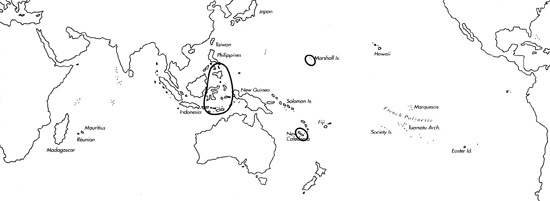
Skip Navigation Links
View access keys for this site.

Range: Philippines, Moluccas and New Caledonia; probably Marshall Is.
Description: Large and solid. Last whorl ovate to narrowly ovate; outline straight at adapical fourth, then convex, straight to slightly concave toward base. Aperture somewhat wider at base than near shoulder. Shoulder angulate. Spire low, outline slightly concave to slightly convex. Larval shell projecting, of about 3.5 whorls; maximum diameter 1- 1.1 mm. About first 3 postnuclear whorls tuberculate. Teleoconch sutural ramps flat, slightly concave in late whorls, with 0-1 increasing to 6-10 spiral grooves. Last whorl with a few very weak spiral ribs at base or completely smooth.
| Shell Morphometry | ||
|---|---|---|
| L | 90-116 mm | |
| RW | 0.30-0.80 g/mm | |
| (L 90-113 mm) | ||
| RD | 0.49-0.53 | |
| PMD | 0.68-0.74 | |
| RSH | 0.04-0.10 | |
Last whorl clouded with light brown except for numerous white dots, triangles and flecks; brown pattern fused into 3 darker spiral bands, below shoulder, above centre and within abapical third. Widely spaced spiral rows of irregularly alternating white and darker brown markings extend from base to shoulder. Siphonal fasciole white or suffused with pale brown. Larval whorls and 1.5-2.5 teleoconch sutural ramps light red. Following ramps light brown, radially mottled with white. Aperture white.
Habitat and Habits: In 180-400 m.
Discussion: C. cervus cannot be mistaken for any of its congeners; C. vicweei is similar in shape but quite different in colour pattern, as noted in the DISCUSSION of that species.

C. cervus range map
This section contains verbatim reproductions of the accounts of 316 species of Conus from the Indo-Pacific region, from Manual of the Living Conidae, by Röckel, Korn and Kohn (1995). They are reproduced with the kind permission of the present publisher, Conchbooks.
All plates and figures referred to in the text are also in Röckel, Korn & Kohn, 1995. Manual of the Living Conidae Vol. 1: Indo-Pacific Region.
The range maps have been modified so that each species account has it own map, rather than one map that showed the ranges of several species in the original work. This was necessary because each species account is on a separate page on the website and not confined to the order of accounts in the book.
Return to framed version (returns to search page)